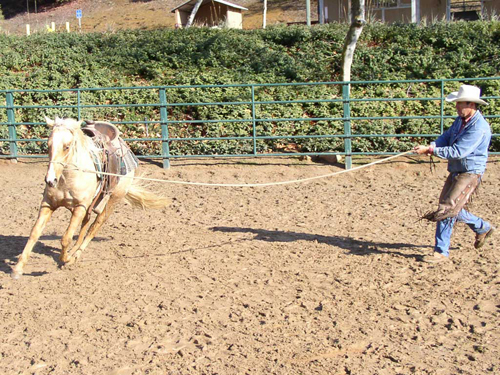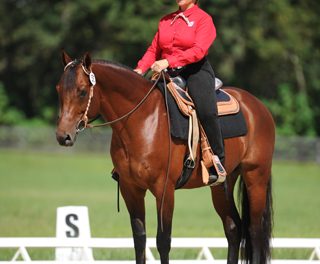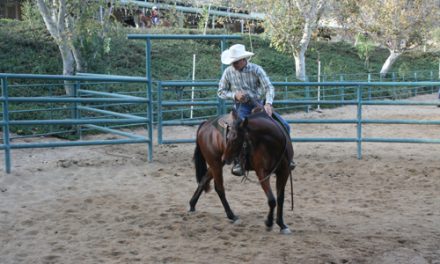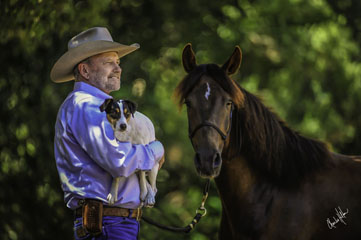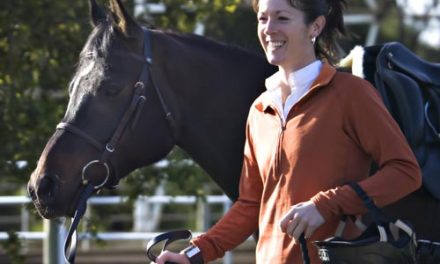
Richard Winters longeing a colt.
I recently walked by a construction site, which had a picture posted of the building that was to go there. As I observed the large mounds of dirt, ditches, culverts, and pipelines, I couldn’t imagine how this chaotic scene would one day resemble the architect’s picture. Yet, experience tells me that it will all come together as envisioned — one step at a time!
I’ve felt the same way when I’ve stepped into the round pen with a young colt to start. How will this thousand pounds of skittish, spooky, and wild horse power ever develop into a gentle, willing, and compliant equine partner? Now that I’ve been through this transformation hundreds, if not thousands, of times, I know the answer: it takes one step at a time!
Step 1. Getting the colt’s attention. I do this by using pressure and release. From the ground, I’ll move the colt around the round pen at the trot. When he does what I’ve asked — that is, when my idea becomes his idea — I’ll release the pressure and see if the colt will stop and look at me. This is where I establish leadership. I’ll have the colt trot in both directions and also do this exercise at the lope.
Step 2. Getting control of the colt’s feet. I want to be able to direct the colt’s feet while he’s on the end of a lead rope. Will he back away when I wiggle the lead? Can I send him left and right in a twenty-foot circle? Can I disengage his hind quarters with his inside foot crossing over his outside foot? As if he’s my dance partner, I must be able to direct his movements in this way.
Step 3. Desensitizing the colt. My body movements and all of my equipment can easily be seen as a threat to my colt. I need to desensitize him to these things.
To desensitize him to my body movements, I start with my hands. I rub him all over with my using with rhythm. This rhythm is vital in helping the colt get comfortable and accepting of me. I’ll also stand next to the colt and hop up and down on the ground with rhythm. I’ll do this on both sides of him. Then I’ll lie over his back — my spine is perpendicular to his — and continue rubbing. What if he starts to move away while I’m on his back? I’ll simply slip back down to the ground and tip his nose to me and disengage his hindquarters. Then I’ll start again. This exercise is not for the inexperienced couch potato! If you’re going to be a colt starter you’d better be mentally and physically up to the challenge.
To desensitize him to equipment, I’ll rhythmically swing the end of my lead rope over his back a number of times, being careful not to let the end spank him on his other side. You could also use the coils of a lariat rope or a horseman’s flag to get him more comfortable and prepared for saddling.
Step 4. Preparing to saddle the colt. I’ll place the lead rope around my colt’s girth, snug it up with my hand, and then ask him to move his feet. These are little things that will help him grasp the “big picture.” Next, I’ll rhythmically rub the saddle pad all over his body, being sure to do both sides of his body. Then, I’ll set the saddle on his back. This is where I need to have feel, timing, and balance. A colt might spook and the saddle can end up on the ground pretty quick. If that happens, I’ll have a leery colt who is convinced that he shouldn’t have that “dead cow” strapped to his back. I smoothly snug up my cinches. Most of my colts will hump up and buck a little (or a lot) when first saddled. That’s OK; a puppy would do the same thing if I tied a ribbon to his tail. If the saddle — or, in the case of the puppy, the ribbon — stays on, the animal soon gets comfortable with it and ignores it.
Sometimes I’ll accomplish all of these steps with a colt in thirty minutes. With other colts, it might take days. This is not a speed event. Like the old horseman said, “Take the time it takes and it will take less time!” It’s a lot for a young horse to digest, and we’ve a long way to go. Yet, we’ll get there, “One step at a time!”
Next month, it’s Mounting Up and Riding Off!
NOTE: This article is not intended to be a comprehensive how-to manual for you to follow. I’ve simply described the steps, in very general and abbreviated terms, which I take to prepare a colt for his first ride.
Richard Winters is a performance horse trainer with a natural horsemanship touch. For over 20 years, he has helped people with their horses through his training programs, clinics, DVDs, and his presentations at horse expos. His horsemanship is universal, ranging from reined cow horses on the Western side to jumping and dressage on the English side. Learn more about Richard at www.wintersranch.com.
Recently, Richard won the 2009 Road to the Horse Colt Starting Competition, which was held March 14 – 15, 2009 in Franklin, Tennessee. Check out the Road to the Horse Web site at www.roadtothehorse.com.

